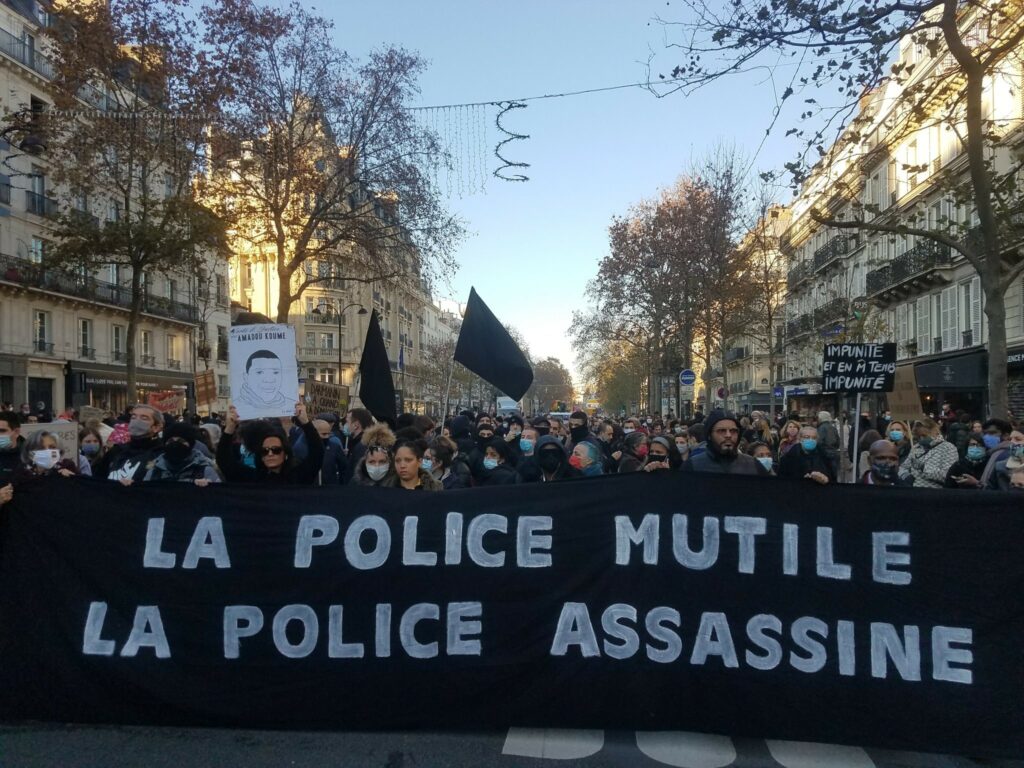
The following is a short dispatch from the comrades in ACTA, a political collective and partisan media project based in France. They provide an in-depth account of the impressive protests that took place across the Hexagon this weekend against the Loi de Sécurité Globale [Global Security Law], a draft bill pushed by the Macron government (with support of major police unions) to reinforce police powers and limit public access to and circulation of surveillance footage and images of police officers, as well as recent highly-visible instances of police violence and crackdowns on migrant populations. While the demonstrations, which saw the participation of many different sectors of French society, caused legislators to announce the rewriting of the most controversial parts of the bill (specifically article 24), ACTA draws our attention to how this mass salvo fits into the recent sequence of intense struggles in the country (and its international relays): not only against the El Khomri Labor Law and the Gilets Jaunes, but also the constant resistance of the inhabitants of the popular neighborhoods and banlieues against police brutality and the racialized exercise of state power.
Hundreds of thousands of people took to the streets across France today (November 28) against the #LoiSécuritéGlobale [Global Security Law], on the occasion of the Marches for Liberty. In a context marked by the powerful circulation of instances of police violence in the media – from the clearing of the Place de la République migrant camp to the gratuitous beating of music producer Michel Zecler in the 17th arrondissement – the Paris demonstration was particularly massive and displayed a level of conflict that has certainly not be seen since the March 16, 2019 Gilets jaunes protest in Paris.
Before the official start of the demonstration, the families of victims of police crimes took turns speaking in front of a banner which read “La police mutile, la police assassine [The police maim, the police kill].” The families marched in several different contingents, some in the front with Amal Bentounsi of the Collectif urgence notre police assassine, others behind a large banner, “ On marche pour nos libertés,” carried among others by the Comité Adama, the Collectif Vies Volées, and the Collectif Oliv’Vit’Haut. This was a way of recalling that the residents of the popular neighborhoods, which have served as laboratories of repression for several decades, are today still the first victims of police violence.
When the Place de la Bastille came in sight, confrontations broke out in the area at 4:00 pm, at the intersection of the Boulevard Beaumarchais and the rue du Pasteur-Wagner, as well as on the other side, at the Rue du Pas de la Mule. Construction barriers, firecrackers, fireworks, paving stones, Molotov cocktails: the first charges announced an especially high degree of intensity. A banner honoring Diego Maradona, the legendary Argentine footballer and symbol of anti-imperialist struggle, led the dance. Diego es pueblo!
While lines of security forces were compelled to retreat on both sides of the boulevard, the demonstration advanced, burning several luxury cars on the way and smashing up a BMW dealership. Once arrived at the Place de la Bastille, the confrontations resumed, with all the exit routes blocked off by a newly reinforced apparatus.
At that moment another banner made its appearance – “Darmanin, you’re going to see blurry” – a nod to the notorious article 24 of the #LoiSécuritéGlobale that aims to prohibit the circulation of images of police actions.1 Meanwhile, a convergence point formed on the right, at the entrance to the rue de la Bastille. Charges and counter-charges punctuated the evening, with several melees from which the police did not always emerge victorious. The Bank of France was also targeted: rocks were thrown at its windows, and then it was set alight.
Overall, the protestors exhibited a rare combativeness, forcing the police to retreat on several occasions. Amid the tear gas, a lone poet, equipped with a makeshift microphone, was able to shout at them ironically: “Boo! Another defeat! You’re worse than Olympique de Marseille!”
The November 28 demo, by its numerical strength, its offensive character, its spirit of revolt and collective solidarity, was a show of force reflecting a generalized social hostility not only against the #LoiSécuritéGlobale but also against the authoritarian tilt of the government, against state racism, against Macron and his world.
The video of Michel Zecler’s beating obviously played a catalyzing role, in roughly the same way that the video of George Floyd’s murder prompted tens of thousands of people to take to the streets for the Comité Adama’s appeal before the Tribunal de grande instance in June. We can also think back to the high schooler from the Lycée Bergson, whose assault at the hands of the police supercharged the dynamic of the movement against the Labor Law in 2016.
The sea of people today was a popular response equal to the situation. It proves how essential it is to continue to film the police and defend ourselves against them, how necessary it is to sustain the pressure against this bankrupt government, so that its bill is buried for good.
– Translated by Viewpoint
References
| ↑1 | Part of the public debate around this article concerned the “blurring” [floutage] of the faces of police officers in videos. Gérald Darmanin is the French Minister of the Interior and a major proponent of the security bill. |
|---|
 Viewpoint Magazine
Viewpoint Magazine